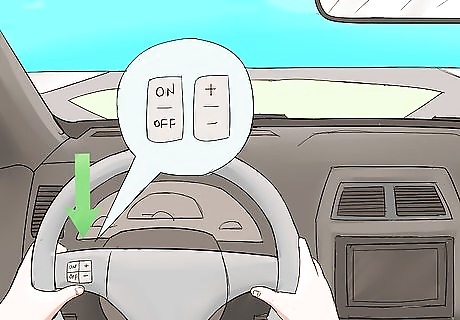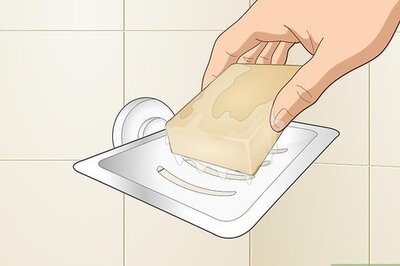
views
Operating Cruise Control

Locate your car's cruise control switches. Usually, these are found either on the steering column (the part connecting the steering wheel to the dashboard area), or on the steering wheel itself. Controls found on the steering wheel usually consist of a few buttons. If car's controls are located on the steering column, look for a lever that sticks out, often near a windshield wiper lever. Check your car's operating manual if you are unable to find the cruise control switches.

Study the layout of the switches. Each car model's controls look slightly different. Generally, however, the controls are labeled clearly. You should see one or two buttons to turn cruise control "ON" and "OFF," another labeled “SET,” and one labeled “RES” (meaning “resume”). Your car may also have a switch labeled “CANCEL.” Familiarize yourself with the location of these buttons. Many cars have additional buttons to increase or decrease speed (marked by a +/-) when using cruise control.

Drive your car until you reach your desired speed and hit “SET.” Cruise control will set the car to hold steady at a particular speed. Once you reach the speed you want (keep an eye on your car's speedometer), push the “SET” button. You can now take your foot off of the gas pedal, and your car will maintain the speed for you. For some car models, cruise control will not operate below a certain speed, such as 40 miles (64 km) per hour.

Stop cruise control whenever you need to. If you need to slow down, stop, turn, or make another change in your driving, it's time to turn cruise control off, or at least pause it. This is easy to do, but there are a few different methods: To stop cruise control briefly (such as when a car in front of you brakes), just press the brake as you normally would. If you are driving a manual, you can also disengage cruise control by pressing the clutch. If you are completely done using cruise control, you can press the “OFF” or "ON/OFF" switch. If your car has a cruise control “CANCEL” switch, you can also press that to stop it.

Resume cruise control, if you want. Sometimes you only need to turn cruise control off momentarily, such as while braking for a car ahead of you. When you're ready to get back into cruise control, just get back up to (or near) your desired speed and hit the “RES” button. This will put your car back into cruise control, at the speed you set previously.

Change the cruise control speed when necessary. For instance, perhaps you have been driving using cruise control on a road where the speed limit is 55 miles (89 km) per hour, and then you enter a zone where the speed limit increases to 70 miles (110 km) per hour. Just press the gas pedal to bring your car up to the new speed, and hit the “SET” button again. This will set cruise control at the new speed. If your car has a +/- button for cruise control, press this when you want to raise or lower your car's speed.
Using Cruise Control Safely and Efficiently

Reserve cruise control for the open road. Cruise control is really meant to be used in situations where you can drive mostly without needing to stop or slow down. It's ideal for driving on freeways and highways. Using cruise control while driving on busy city streets doesn't make any sense, because of all the stopping and starting you will have to do. Using cruise control on busy streets can also be dangerous. Since you yourself are not in complete control of your car, you may be paying less attention. You might brake or react to other cars more slowly than normal, increasing the chance of an accident.

Avoid using cruise control in hazardous conditions. Cruise control can slightly slow your reaction time and keeps you from having total control over acceleration. This means it's best not to use it in situations where road conditions require more careful and nuanced driving. These include: Wet or snowy roads Hilly, steep, or mountainous areas Winding roads

Stay focused on the road. Cruise control is not auto-pilot. You will still need to stay focused on the road. Scan the road constantly for any upcoming hazards or other vehicles. Keep your feet near the brake pedal at all times (not folded under you on the seat or propped up on the dash) in case you need to slow or stop quickly. Most of all, keep your mind on driving: don't zone out!

Use cruise control to maximize fuel economy and ensure you maintain a safe speed. Your car's engine runs more efficiently in conditions where cruise control is engaged safely. Since you can set it at a specific speed, it's also a way to avoid getting a speeding ticket if you have a lead foot. Just set it at or below the speed limit! Finally, cruise control lets you relax a little as you drive, which can reduce fatigue on long trips.
















Comments
0 comment